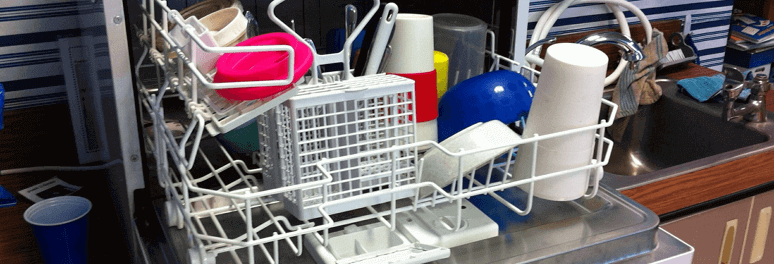
If you want to get the best out of your household appliances you need to maintain them properly and use them correctly. When considering dishwashers, incorrect loading is the biggest cause of poor performance. It’s always worth checking your owners manual for any brand or model specific instructions but the following general rules will guide you through how to load it so that it works most efficiently.
Dishwasher Essentials
Always scrap off food debris first – There’s no point in making your dishwasher work harder than it has to, food scraps will fill up traps and could even block the drain hose.
Rinse if you’re leaving dirty dishes to stand – This may apply if you only use the machine once a day or less. But if you’re planning to load and use it immediately you don’t need to pre-rinse your dishes.
Don’t overload – Water jets need to get to the dirty surfaces and if you pile items on top of each other they can’t. It’s better to wash a few items by hand, or put them to one side for a second load then to have things come out still dirty.
The Bottom Rack
This is designed to take cookware, large plates and dishes and baking trays (dishwasher safe ones).
1. Pots and pans need to angle downwards to get the best results.
2. Plates and dishes should be arranged so that the dirty side faces the water jets.
3. Flat trays can along the sides or at the back of the rack. Nat the front as they’ll block water jets from reaching everything else in the machine.
The Top Rack
This is the place for small dishes, cups, side plates, glasses and dishwasher safe plastics.
1. Cups and glasses go face down between the tines, don’t put them on top of the prongs as you can end up with a mark inside the item.
2. Angle cups as far as possible, to avoid pools of water on the top.
3. Don’t let delicate glasses touch each other, if they bump they might break and you don’t want to have to unload a dishwasher full of broken glass.
4. Make sure plastics are securely loaded. They’re light enough to flip, and fall onto the heating element where they’ll melt and damage your machine.
Incorrect loading can damage your machine. And while it’s one thing to book dishwasher repairs North London because your machine develops a fault, it’s quite another to have to pay a bill to fix something you could have prevented with a little more care.
The Cutlery Tray
No list of dishwasher tips and tricks would be complete without mentioning knives, forks and spoons. The important thing here is to mix them up so they can’t nest. Some people recommend placing some pieces handle up and others handle down, to further reduce the risk of nesting. Knives should always go handle up though so you won’t cut yourself as you’re unloading.
What Not to Put in Your Dishwasher
Sharp kitchen knives are best cleaned by hand as the heat and chemicals in a dishwasher aren’t good for them. Bronze, wood or fine china are best dealt with in the washing up bowl too. Some non-stick pans will cope with the machine washing, others will not. Check the base for a dishwasher safe symbol.
Finally, make sure you’re using the correct detergent type and amount for your appliance and bear in mind that like foods, some detergents have a shelf-life. Aim to use anything you buy within two months.



